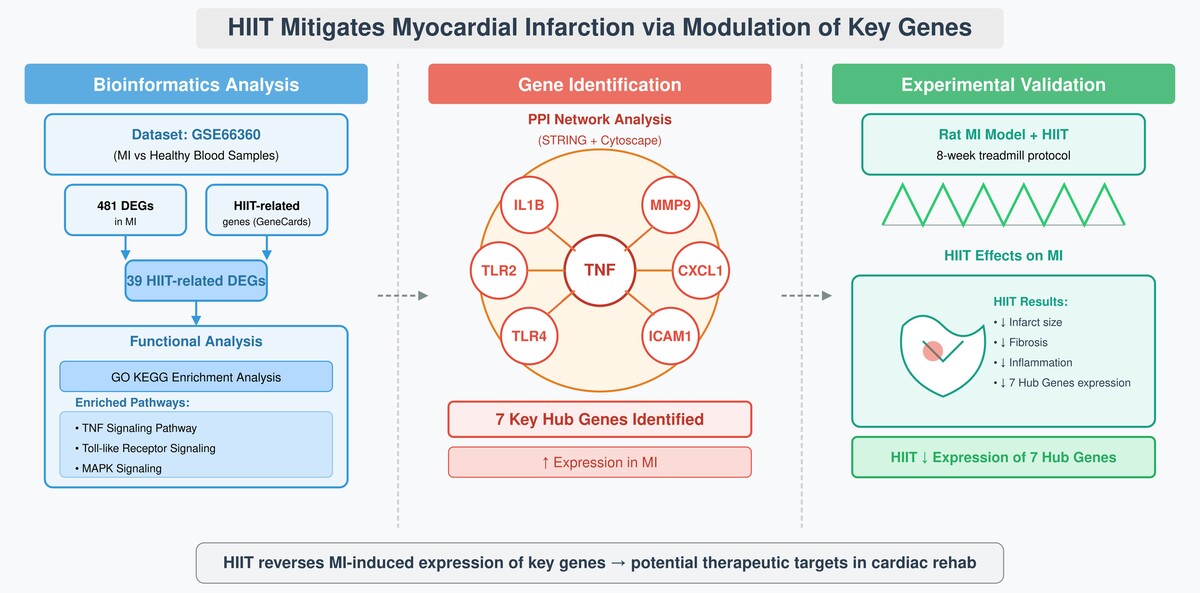Current issue
Archive
Manuscripts accepted
About the Journal
Editorial office
Editorial board
Section Editors
Abstracting and indexing
Subscription
Contact
Ethical standards and procedures
Most read articles
Instructions for authors
Article Processing Charge (APC)
Regulations of paying article processing charge (APC)
CARDIOVASCULAR PREVENTION / RESEARCH PAPER
High-Intensity Interval Training: Unveiling the Seven Key Genes Mediating Cardioprotection in Myocardial Infarction
1
Guangxi Normal University, China
Submission date: 2025-04-29
Final revision date: 2025-08-05
Acceptance date: 2025-08-05
Online publication date: 2025-10-26
KEYWORDS
TOPICS
ABSTRACT
Introduction:
Myocardial infarction (MI) is a leading cause of mortality, driven by inflammation and cardiac remodeling. While high-intensity interval training (HIIT) improves MI outcomes, its molecular mechanisms remain poorly defined, limiting therapeutic optimization. This study aimed to identify molecular targets and signaling pathways modulated by HIIT in MI, uncovering new therapeutic strategies for cardiovascular recovery.
Material and methods:
Differential gene expression analysis of GSE66360 dataset, comprising circulating endothelial cells from MI patients (n=49) and healthy controls (n=50), identified 481 DEGs. Cross-referencing with 717 HIIT-related genes from GeneCards revealed 39 overlapping genes. PPI and functional enrichment analyses highlighted seven hub genes: TNF, IL1B, MMP9, TLR4, ICAM1, TLR2, and CXCL1. These were validated by RT-qPCR in MI patients and controls (n=20 each). MI was induced in rats (n=8 per group), followed by an 8-week HIIT regimen. Infarct size, fibrosis, and protein expression were assessed using TTC staining, histology, and Western blot.
Results:
We identified 481 DEGs in MI (351 upregulated, 130 downregulated; FDR-adjusted p < 0.05, |log2 fold change| > 1), with 39 overlapping HIIT-related genes. Seven hub genes (TNF, IL1B, MMP9, TLR4, ICAM1, TLR2, CXCL1) were upregulated in MI patients (p < 0.001, RT-qPCR). In MI rats, HIIT reduced infarct size by 32% (p < 0.01), decreased fibrosis and inflammatory cell infiltration (p < 0.05), and downregulated all seven hub genes (p < 0.05). Enrichment analyses linked these genes to TNF and TLR pathways, highlighting HIIT’s anti-inflammatory effects.
Conclusions:
HIIT protects the heart post-MI by targeting inflammatory and remodeling pathways, providing a basis for precision cardiovascular therapy.
Myocardial infarction (MI) is a leading cause of mortality, driven by inflammation and cardiac remodeling. While high-intensity interval training (HIIT) improves MI outcomes, its molecular mechanisms remain poorly defined, limiting therapeutic optimization. This study aimed to identify molecular targets and signaling pathways modulated by HIIT in MI, uncovering new therapeutic strategies for cardiovascular recovery.
Material and methods:
Differential gene expression analysis of GSE66360 dataset, comprising circulating endothelial cells from MI patients (n=49) and healthy controls (n=50), identified 481 DEGs. Cross-referencing with 717 HIIT-related genes from GeneCards revealed 39 overlapping genes. PPI and functional enrichment analyses highlighted seven hub genes: TNF, IL1B, MMP9, TLR4, ICAM1, TLR2, and CXCL1. These were validated by RT-qPCR in MI patients and controls (n=20 each). MI was induced in rats (n=8 per group), followed by an 8-week HIIT regimen. Infarct size, fibrosis, and protein expression were assessed using TTC staining, histology, and Western blot.
Results:
We identified 481 DEGs in MI (351 upregulated, 130 downregulated; FDR-adjusted p < 0.05, |log2 fold change| > 1), with 39 overlapping HIIT-related genes. Seven hub genes (TNF, IL1B, MMP9, TLR4, ICAM1, TLR2, CXCL1) were upregulated in MI patients (p < 0.001, RT-qPCR). In MI rats, HIIT reduced infarct size by 32% (p < 0.01), decreased fibrosis and inflammatory cell infiltration (p < 0.05), and downregulated all seven hub genes (p < 0.05). Enrichment analyses linked these genes to TNF and TLR pathways, highlighting HIIT’s anti-inflammatory effects.
Conclusions:
HIIT protects the heart post-MI by targeting inflammatory and remodeling pathways, providing a basis for precision cardiovascular therapy.
We process personal data collected when visiting the website. The function of obtaining information about users and their behavior is carried out by voluntarily entered information in forms and saving cookies in end devices. Data, including cookies, are used to provide services, improve the user experience and to analyze the traffic in accordance with the Privacy policy. Data are also collected and processed by Google Analytics tool (more).
You can change cookies settings in your browser. Restricted use of cookies in the browser configuration may affect some functionalities of the website.
You can change cookies settings in your browser. Restricted use of cookies in the browser configuration may affect some functionalities of the website.



